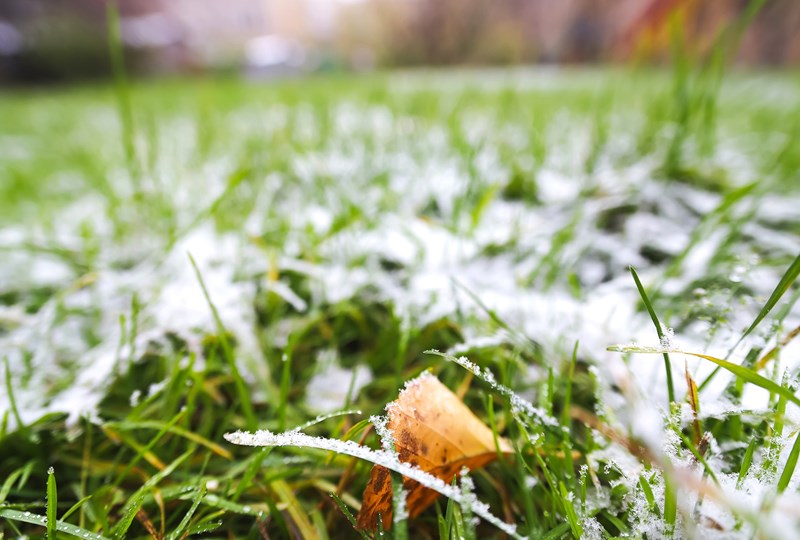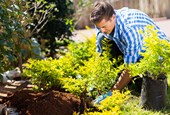
When it comes to spring lawn care in the Midwest, it’s easy to get overwhelmed. As the weather warms up and yards are flooded with snowmelt, it can be difficult to know what your lawn needs — and when.
Here are spring lawn care tips and insights you can use to get your yard in peak condition by early summer.
Tips on caring for Minnesota and Wisconsin lawns
As eternal optimists, we want to share some good news about how the spring thaw works in the Midwest. While lawns in warmer climates can only stand up to about four days of flooding before they may require all-new soil and sod, our Midwestern ground is able to endure standing water for longer. This is because our ground is thawing at the same time as the snow is melting — and before the grass has begun to grow again for the season.
So, even if your lawn is covered in standing water for a week or more, it’s likely hardy enough to sustain the damage from typical spring snowmelt, and even a bit of flooding. By following these spring lawn care steps, you can ensure your yard recovers fully from the early spring melt.
Prepare your lawn mower and yard equipment
First, as you eagerly await the spring season, focus on getting your lawn equipment in order. Make sure your lawnmower is serviced and that the blades are sharp. When sub-zero temperatures are in the rearview mirror, reconnect your hoses and turn on your exterior water supply. Last, check that in-ground sprinklers weren’t damaged during the snowy winter months.
March
While March isn’t always the start of spring here in Minnesota and Wisconsin, we do typically see a bit of snowmelt during this time. Take time to focus on early spring lawn preparation by picking up trash and debris that may have fallen in winter storms. Give your lawn time to dry out and allow the grass to start growing again. If spring arrives late, aim to complete the majority of the below tasks by mid-April instead.
Do’s:
- Do rake your lawn to loosen up the soil and break up clumps.
- Do remove excess leaves, branches and dead grass so your grass can grow freely.
- Do wait until the grass has reached 2-3 inches to mow for the first time.
Don’ts:
- Don’t fire up the lawnmower if the blade is dull! Dull blades rip grass from the root.
- Don’t set your lawnmower to a short setting. By keeping it at the highest setting, your grass will grow thicker, faster.
- Don’t mow if you haven’t lightly raked the lawn and cleaned up the winter yard waste.
April
In April, spring lawn care and treatment will begin in earnest. You’ll want to watch for green growth and keep a close eye on thatch. Over the winter, dead grass, roots and other plant stems may have broken off and bound together. This creates a layer of impenetrable “thatch” that won’t allow water and nutrients in; it will also prevent new grass growth from sprouting freely. If your thatch is more than ¾ inch thick, you’ll either want to:
- Aerate your soil: Remove plugs of grass and soil so that water and nutrients can gain access to your grass’ roots.
- Dethatch the ground: Remove thatch from your lawn using a rake, power rake or vertical mower.
Do’s:
- Do wait until you have mowed two times to aerate your lawn.
- Do rent an aeration machine from a hardware store, as your lawn may not require aeration every year.
- Do consult an expert before dethatching your lawn.
Don’ts:
- Don’t aerate your lawn if your thatch is less than ½ inch thick.
- Don’t use a vertical mower unless you absolutely have to. In addition to pulling out thatch, a vertical mower may pull out the roots of your grass.
May
By May, your lawn should be returning to normal and the problem spots will become apparent. Now is the time for some targeted spring lawn treatment. While fall is the best time to overseed lawns in colder climates like the Midwest, you should be able to successfully overseed patchy areas in your yard in late April and early May. If the majority of your lawn is free of overseed, continue mowing it.
Do’s:
- Do check with a lawn care specialist, who can help you determine what kind of seed is best for your problem areas.
- Do water your seed daily, unless the area seems to be exceptionally moist.
- Do focus your sprinkler only on the areas you’ve overseeded.
Don’ts:
- Don’t water your entire lawn unless it’s been an exceptionally warm spring.
- Don’t mow too low or bag up your grass clippings. Grass clippings make excellent (and free!) natural fertilizer.
Stand back, and admire your work
As the thatch recedes and yellowed grass turns into a thick cover of green, be sure to take a step back and admire your handiwork. While spring lawn care can test your patience and take up a lot of time, it’s also the best way to ensure your yard is looking its best throughout our gorgeous summer months in the Midwest.
And if you spruced up your lawn in order to attract spring and summer buyers, reach out to Edina Realty or your agent today to discuss setting up a smart seller plan.










 Equal Housing Lender | Prosperity Home Mortgage, LLC may operate as Prosperity Home Mortgage, LLC dba Edina Realty Mortgage in Minnesota and Wisconsin. ©2024 Prosperity Home Mortgage, LLC dba Edina Realty Mortgage. (877) 275-1762. 3060 Williams Drive, Suite 600, Fairfax, VA 22031. All first mortgage products are provided by Prosperity Home Mortgage, LLC. Not all mortgage products may be available in all areas. Not all borrowers will qualify. NMLS ID #75164 (For licensing information go to: NMLS Consumer Access at http://www.nmlsconsumeraccess.org/) Licensed by the Department of Financial Protection and Innovation under the California Residential Mortgage Lending Act. Licensed by the Delaware State Bank Commissioner. Georgia Residential Mortgage Licensee. Massachusetts Mortgage Lender and Mortgage Broker MC75164. Licensed by the NJ Department of Banking and Insurance. Licensed Mortgage Banker-NYS Department of Financial Services. Rhode Island Licensed Lender. Rhode Island Licensed Loan Broker. Rhode Island Licensed Third-Party Loan Servicer. Also licensed in AK, AL, AR, AZ, CO, CT, DC, FL, ID, IL, IN, KS, KY, LA, MD, ME, MI, MN, MO, MS, MT, NC, ND, NE, NH, NM, NV, OH, OK, OR, PA, SC, SD, TN, TX, UT, VA, VT, WA, WI, WV and WY.
Equal Housing Lender | Prosperity Home Mortgage, LLC may operate as Prosperity Home Mortgage, LLC dba Edina Realty Mortgage in Minnesota and Wisconsin. ©2024 Prosperity Home Mortgage, LLC dba Edina Realty Mortgage. (877) 275-1762. 3060 Williams Drive, Suite 600, Fairfax, VA 22031. All first mortgage products are provided by Prosperity Home Mortgage, LLC. Not all mortgage products may be available in all areas. Not all borrowers will qualify. NMLS ID #75164 (For licensing information go to: NMLS Consumer Access at http://www.nmlsconsumeraccess.org/) Licensed by the Department of Financial Protection and Innovation under the California Residential Mortgage Lending Act. Licensed by the Delaware State Bank Commissioner. Georgia Residential Mortgage Licensee. Massachusetts Mortgage Lender and Mortgage Broker MC75164. Licensed by the NJ Department of Banking and Insurance. Licensed Mortgage Banker-NYS Department of Financial Services. Rhode Island Licensed Lender. Rhode Island Licensed Loan Broker. Rhode Island Licensed Third-Party Loan Servicer. Also licensed in AK, AL, AR, AZ, CO, CT, DC, FL, ID, IL, IN, KS, KY, LA, MD, ME, MI, MN, MO, MS, MT, NC, ND, NE, NH, NM, NV, OH, OK, OR, PA, SC, SD, TN, TX, UT, VA, VT, WA, WI, WV and WY.